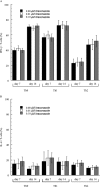Failure of itraconazole to prevent T-helper type 2 cell immune deviation: Implications for chronic rhinosinusitis
- PMID: 28124646
- PMCID: PMC5108838
- DOI: 10.2500/ajra.2016.30.4362
Failure of itraconazole to prevent T-helper type 2 cell immune deviation: Implications for chronic rhinosinusitis
Abstract
Background: T-helper (Th) type 2 cell inflammation is the hallmark of several disease processes, including asthma, atopic dermatitis, and some forms of chronic rhinosinusitis. Itraconazole has been used as both an antifungal and an anti-inflammatory agent, with some success in many of these diseases, in part, by altering Th2 cytokine expression by T cells. It is not known whether this merely reflects inhibition of established Th2-like cells or the inhibition of differentiation of naive T cells into Th2-like cells.
Objective: To evaluate the role of itraconazole in the differentiation of naive T cells during activation.
Methods: Naive CD45RA+ T cells were isolated from peripheral blood mononuclear cells from healthy volunteers. Th1 and Th2 type cells were differentiated in the presence of varying concentrations of itraconazole. After stimulation with anti-CD3 and anti-CD28 beads, carboxyfluorescein succinimidyl ester dilution was performed to evaluate proliferation and intracellular cytokine staining for interleukin (IL) 4 and interferon (IFN) gamma within proliferating T cells was measured along with enzyme-linked immunosorbent assay for secreted IL-5, IL-13, and IFN gamma.
Results: Itraconazole had no effect on proliferation of unbiased, Th1, or Th2 cells. Similarly, there was no effect of itraconazole on either intracellular cytokine staining of IL-4 and IFN gamma or secreted cytokine expression of IFN gamma, IL-5, and IL-13 in any of the cell populations.
Conclusion: Itraconazole did not alter the ability of naive T cells to proliferate or secrete cytokines under Th1 or Th2 deviating conditions in vitro. As such, reported inhibition of Th2-like lymphocyte function by itraconazole reflected action on mature effector cells and may have underscored why antifungal treatment failed in many clinical trials of eosinophilic chronic rhinosinusitis.
Conflict of interest statement
The authors have no conflicts of interest to declare pertaining to this article
Figures




Similar articles
-
Immunomodulation by mercuric chloride in vitro: application of different cell activation pathways.Clin Exp Immunol. 2007 May;148(2):325-37. doi: 10.1111/j.1365-2249.2007.03338.x. Epub 2007 Feb 14. Clin Exp Immunol. 2007. PMID: 17302730 Free PMC article.
-
Granulocyte colony-stimulating factor decreases the Th1/Th2 ratio in peripheral blood mononuclear cells from patients with chronic immune thrombocytopenic purpura in vitro.Thromb Res. 2016 Dec;148:76-84. doi: 10.1016/j.thromres.2016.10.028. Epub 2016 Oct 28. Thromb Res. 2016. PMID: 27815970
-
The influence of hydro-ethanolic extract of Portulaca oleracea L. on Th1/Th2 balance in isolated human lymphocytes.J Ethnopharmacol. 2016 Dec 24;194:1112-1121. doi: 10.1016/j.jep.2016.10.082. Epub 2016 Nov 10. J Ethnopharmacol. 2016. PMID: 27842944
-
Immune modulation for treatment of allergic disease.Immunol Rev. 2011 Jul;242(1):258-71. doi: 10.1111/j.1600-065X.2011.01034.x. Immunol Rev. 2011. PMID: 21682751 Review.
-
An alternate mechanism of glucocorticoid anti-proliferative effect: promotion of a Th2 cytokine-secreting profile.Clin Transplant. 1999 Oct;13(5):365-74. doi: 10.1034/j.1399-0012.1999.130501.x. Clin Transplant. 1999. PMID: 10515216 Review.
Cited by
-
Paradigm shifts in the medical and surgical management of rhinologic and allergic disease.Am J Rhinol Allergy. 2016 Nov 1;30(6):377-378. doi: 10.2500/ajra.2016.30.4398. Am J Rhinol Allergy. 2016. PMID: 28124645 Free PMC article. No abstract available.
-
Comparison of the effects of itraconazole and prednisolone on fibroblast growth factor-2 gene expression and clinical manifestations in patients with persistent severe asthma.Curr Med Mycol. 2023 Jun;9(2):1-9. doi: 10.22034/CMM.2023.345036.1401. Curr Med Mycol. 2023. PMID: 38375524 Free PMC article.
References
MeSH terms
Substances
Grants and funding
LinkOut - more resources
Full Text Sources
Other Literature Sources
Medical
Research Materials

